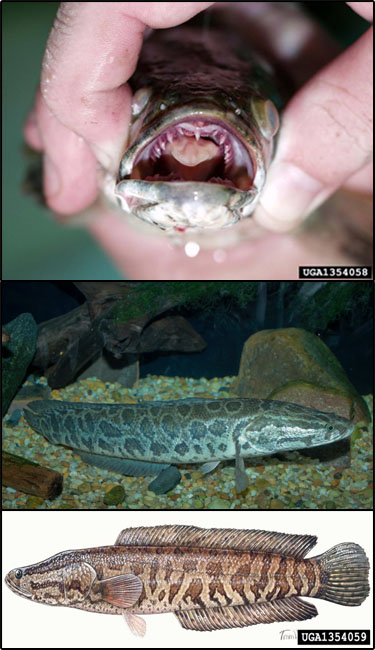Northern snakehead (Channa argus)
 Description: Currently established populations are in the Potomac River drainage in Maryland and possibly in the lower White River system in Arkansas. Northern snakeheads were introduced intentionally by Asian food importers to establish harvestable populations for consumption. There have also been introductions by pet owners. The first report of an introduced northern snakehead was in 1997; they have been found in eight U.S states since then.
Description: Currently established populations are in the Potomac River drainage in Maryland and possibly in the lower White River system in Arkansas. Northern snakeheads were introduced intentionally by Asian food importers to establish harvestable populations for consumption. There have also been introductions by pet owners. The first report of an introduced northern snakehead was in 1997; they have been found in eight U.S states since then.Identification: Brown body with dark brown blotches along sides and back; dark fins. Dark stripes from eye to edge of gill cover. Long, cylindrical body with rounded caudal fin that lacks ocellus. Scales on top of the head; large terminal mouth. Can grown up to 33 inches. Can breathe air and has the ability to survive up to four days without water.
Habitat: Native to China and Korea. Prefer pools over sand or rocks, often near vegetation.
Reproduction: These invasives have a robust reproduction rate, spawning one to five times a year, with 1,300 to 15,000 eggs released each spawn.
Impact and Damage: Northern snakeheads are voracious eaters and can prey on a wide variety of native fishes, becoming a threat to those species as well as the native predators they are competing with. Their populations also have the ability to grow and spread quickly due to their lack of natural predators, adaptability to a wide range of temperatures and their high fertility rates. There is also a concern that northern snakeheads can introduce parasites and diseases that could harm native fishes.
Similar species: North American bowfin (Amia calva), which can be distinguished by a rounded tail and an eyespot near the tail in males; Blotched snakehead (Channa maculata), which can be distinguished by its car-like markings on the caudal peduncle; and the Burbot (Lota lota), which can be distinguished by a split dorsal fin and a single barbel on the lower jaw.
Monitoring and rapid response: The U.S Fish and Wildlife Service and its partners are monitoring populations of northern snakeheads and conducting research to assess their impacts on ecosystems. The Virginia Department of Game and Inland Fisheries, Maryland Department of Natural Resourced, D.C. Fisheries and Wildlife, and the U.S. Fish and Wildlife Service are using reward tags on snakeheads to help determine the size of the population in the Potomac River and to better understand their movement through the river and its tributaries. Credits: The information contained in this factsheet was provided by the Shedd Aquarium and the Global Invasive Species Database. Photos (T-B) courtesy of the U.S Geological Survey, Brian Gratwicke, and Susan Trammell.
STATUS | Priority Species |
Common Name: | Northern snakehead |
Scientific Name: | Channa argus |
Family: | Channidae (Freshwater perciform fish) |
Habit: | Fish |
 View Species Course |
|
